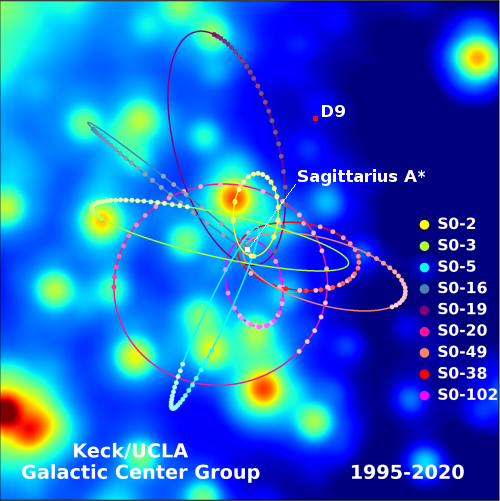Astronomers discover 1st binary star system orbiting Milky Way’s central supermassive black hole

The stars orbiting Sag A*. Click for original image.
Using infrared spectroscopic data gathered from 2005 to 2019 by the Very Large Telescope in Chile, astronomers have identified the first known binary star system to orbit Sagittarius A* (pronounced “A-star”), the Milky Way’s central supermassive black hole.
You can read their science paper here [pdf]. The white dot at the center of the map to the right marks the location of Sagittarius A*, while the red dot marks the present location of the binary star, dubbed D9. The other objects are the stars previously identified orbiting the central black hole, all of which are now believed to be single stars. The binary D9 has an estimated orbit around Sagittarius A* of 432 years and is thought to be less than three million years old. The two stars have approximate masses of 3.86 and 2.8 solar masses, with the smaller orbiting the larger every 372 days.
There is a lot of uncertainty in these numbers, but the data identifying the binary is quite firm. This discovery, as well as the many other stars now known to orbit Sagittarius A*, show that star formation so close to a supermassive black hole is not only possible, it is common, something astronomers a decade ago thought impossible.
On Christmas Eve 1968 three Americans became the first humans to visit another world. What they did to celebrate was unexpected and profound, and will be remembered throughout all human history. Genesis: the Story of Apollo 8, Robert Zimmerman's classic history of humanity's first journey to another world, tells that story, and it is now available as both an ebook and an audiobook, both with a foreword by Valerie Anders and a new introduction by Robert Zimmerman.
The print edition can be purchased at Amazon or from any other book seller. If you want an autographed copy the price is $60 for the hardback and $45 for the paperback, plus $8 shipping for each. Go here for purchasing details. The ebook is available everywhere for $5.99 (before discount) at amazon, or direct from my ebook publisher, ebookit. If you buy it from ebookit you don't support the big tech companies and the author gets a bigger cut much sooner.
The audiobook is also available at all these vendors, and is also free with a 30-day trial membership to Audible.
"Not simply about one mission, [Genesis] is also the history of America's quest for the moon... Zimmerman has done a masterful job of tying disparate events together into a solid account of one of America's greatest human triumphs."--San Antonio Express-News

The stars orbiting Sag A*. Click for original image.
Using infrared spectroscopic data gathered from 2005 to 2019 by the Very Large Telescope in Chile, astronomers have identified the first known binary star system to orbit Sagittarius A* (pronounced “A-star”), the Milky Way’s central supermassive black hole.
You can read their science paper here [pdf]. The white dot at the center of the map to the right marks the location of Sagittarius A*, while the red dot marks the present location of the binary star, dubbed D9. The other objects are the stars previously identified orbiting the central black hole, all of which are now believed to be single stars. The binary D9 has an estimated orbit around Sagittarius A* of 432 years and is thought to be less than three million years old. The two stars have approximate masses of 3.86 and 2.8 solar masses, with the smaller orbiting the larger every 372 days.
There is a lot of uncertainty in these numbers, but the data identifying the binary is quite firm. This discovery, as well as the many other stars now known to orbit Sagittarius A*, show that star formation so close to a supermassive black hole is not only possible, it is common, something astronomers a decade ago thought impossible.
On Christmas Eve 1968 three Americans became the first humans to visit another world. What they did to celebrate was unexpected and profound, and will be remembered throughout all human history. Genesis: the Story of Apollo 8, Robert Zimmerman's classic history of humanity's first journey to another world, tells that story, and it is now available as both an ebook and an audiobook, both with a foreword by Valerie Anders and a new introduction by Robert Zimmerman.
The print edition can be purchased at Amazon or from any other book seller. If you want an autographed copy the price is $60 for the hardback and $45 for the paperback, plus $8 shipping for each. Go here for purchasing details. The ebook is available everywhere for $5.99 (before discount) at amazon, or direct from my ebook publisher, ebookit. If you buy it from ebookit you don't support the big tech companies and the author gets a bigger cut much sooner.
The audiobook is also available at all these vendors, and is also free with a 30-day trial membership to Audible.
"Not simply about one mission, [Genesis] is also the history of America's quest for the moon... Zimmerman has done a masterful job of tying disparate events together into a solid account of one of America's greatest human triumphs."--San Antonio Express-News


-broken link for the picture….
wayne: Link fixed.
As Chief O’Doul said, “Speculations about a hypothesis. I know I don’t know nothing…”
This area of space needs to be the first target of a solar foci telescope.
You launch one on the other side of the Sun from the Milky Way core.
This way, you are bound to have other objects of interest pass into frame even if you have a bit of trouble in alignment.
A target rich environment is the best way to dial in a fociscope
The next target–Andromeda—then Gliese 710, since it is moving towards us.
Barnard’s Star moves too fast.